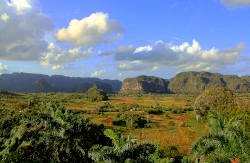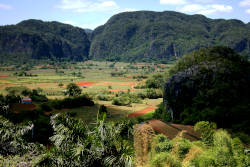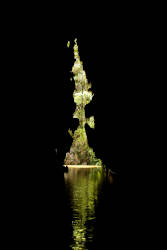Cuevas del Indio
Indio Caves
Useful Information


| Location: | 8 km north of Viñales. Viñales Valley, Pinar de Rio, Western Cuba. On the road to San Vicente, signposted from Viñales. |
| Open: |
All year daily 9-17. [2020] |
| Fee: |
Adults CUC 5. [2020] |
| Classification: |
 Karst Cave Karst Cave
|
| Light: |
 Incandescent Incandescent
|
| Dimension: | L=1,000m |
| Guided tours: | L=1,500 m. |
| Photography: | allowed |
| Accessibility: | no |
| Bibliography: | |
| Address: | Cueva del Indio, Viñales Valley, Pinar del Río, |
| As far as we know this information was accurate when it was published (see years in brackets), but may have changed since then. Please check rates and details directly with the companies in question if you need more recent info. |
|
History
| 1920 | cave discovered by a peasant named Juan Díaz. |
Description

The Cueva del Indio (Indio Caves) are unique, because after walking a few hundred meters into the cave, the visitors arrive at a subterranean river. There the group boards a motor boat, and motor up the cave river a bit and then back down river and right out of the cave. The water level was originally not high enough for boats, but the river was dammed. On the boat it is hard to hear the explanations over the sound of the motor and the boat never stops. Even more disappointing is probably the market of curio sellers you reach after you left the cave.
Every night thousands of bats fly out of the cave. The cave was also visited by the pre-Columbian indigenous people, hence the name. Their remains were discovered in the cave, including some cave paintings. The Indio reenactment at the entrance is not for everyone, many visitors found it quite boring. The same goes for the multiple souvenir shops at the exit. This seems to be a Cuban thing, to open a tourist shop everywhere. In the last years the cave was often crowded during the main season, so it is possibly a good idea to avoid weekends or go early in the morning.
Visitors are shown to the entrance where a tall, concrete floored and decorated rift passage leads into the mogote. Visitors follow this unguided part of the tour at their own pace until, after 250 m or so, they arrive at a stream passage about 10 m wide and twice as high. Here a guide ushers visitors into a flat bottomed boat and then drives them upstream to where the passage terminates at a tall cascade (looks like a pitch coming in from a higher level passage).
The boat then turns around and heads downstream at a more leisurely pace with the guide pointing out various formations. The tour progresses past the embarkation point and around a couple of bends to where the stream exits the mogote into daylight and the end of the tour. Occasionally, to demonstrate the acoustics of the cave, a small cannon is fired as the boat approaches the exit.
Water levels within the stream passage are maintained by means of a weir just outside the exit.
Text by Bob Wilkins (2003). With kind permission.
 Search DuckDuckGo for "Cuevas del Indio"
Search DuckDuckGo for "Cuevas del Indio" Google Earth Placemark
Google Earth Placemark Cueva del Indio - Wikipedia (visited: 06-DEC-2020)
Cueva del Indio - Wikipedia (visited: 06-DEC-2020) Cueva del Indio, Cuba (visited: 06-DEC-2020)
Cueva del Indio, Cuba (visited: 06-DEC-2020) Index
Index Topics
Topics Hierarchical
Hierarchical Countries
Countries Maps
Maps